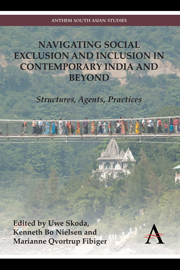 Navigating Social Exclusion and Inclusion in Contemporary India and Beyond
Navigating Social Exclusion and Inclusion in Contemporary India and Beyond Book contents
- Frontmatter
- Contents
- Acknowledgements
- List of Contributors
- 1 Introduction: Navigating Exclusion, Engineering Inclusion
- Part I Spaces and Values
- Part II Communities and Politics
- 5 In Search of Development: Muslims and Electoral Politics in an Indian State
- 6 Exclusion as Common Denominator: Investigating ‘Dalit-hood’
- 7 Inclusion of the Excluded Groups through Panchayati Raj: Electoral Democracy in Uttar Pradesh
- 8 Making Sikkim More Inclusive: An Insider's View of the Role of Committees and Commissions
- 9 Encountering ‘Inclusion’ and Exclusion in Postindustrial Mumbai: A Study of Muslim Ex-millworkers' Occupational Choices
- Part III Resources and Development
8 - Making Sikkim More Inclusive: An Insider's View of the Role of Committees and Commissions
from Part II - Communities and Politics
Published online by Cambridge University Press: 05 September 2013
- Frontmatter
- Contents
- Acknowledgements
- List of Contributors
- 1 Introduction: Navigating Exclusion, Engineering Inclusion
- Part I Spaces and Values
- Part II Communities and Politics
- 5 In Search of Development: Muslims and Electoral Politics in an Indian State
- 6 Exclusion as Common Denominator: Investigating ‘Dalit-hood’
- 7 Inclusion of the Excluded Groups through Panchayati Raj: Electoral Democracy in Uttar Pradesh
- 8 Making Sikkim More Inclusive: An Insider's View of the Role of Committees and Commissions
- 9 Encountering ‘Inclusion’ and Exclusion in Postindustrial Mumbai: A Study of Muslim Ex-millworkers' Occupational Choices
- Part III Resources and Development
Summary
A large number of tribes in India were brought into the Hindu fold, of course, in very different and often uneven ways, over the past several centuries. Some of them, like the Meiteis and Ahoms in India's Northeast, were accepted as Kshatriyas while others like Rajbansis in North Bengal were accorded the status of Shudras in the varna order. There may be several reasons for such variations in what Nirmal Kumar Bose (1941), a doyen of Indian anthropology, called the ‘Hindu method of tribal absorption’, but if a tribe being absorbed has an inferior status vis-à-vis a dominant Hindu majority community, the former seems to have little or no chance of being accepted as a cultural equal, as was the case of Rajbansis vis-à-vis the dominant Bengali Hindus. Ahoms and Meiteis, on the other hand, did not face any dominant majority community as the Rajbansis did, and were instead themselves locally ‘dominant’.
Sikkim, an erstwhile Himalayan kingdom ruled by the Namgyals from 1641 until its so-called ‘merger’ with the Union of India in 1975, was so located with Tibet on its north, Nepal on its west, Bhutan on its east and the Darjeeling district of West Bengal on its south, that it never experienced the ‘kshatriyaization’ movement of the seventeenth and eighteenth centuries that swept the valleys of Northeast India. Sikkim may have been left out also because it clearly did not then have Hindu population which would be prone to such a movement; its population was, until the end of nineteenth century, either Buddhists or Animists.
- Type
- Chapter
- Information
- Navigating Social Exclusion and Inclusion in Contemporary India and BeyondStructures, Agents, Practices, pp. 135 - 148Publisher: Anthem PressPrint publication year: 2013


